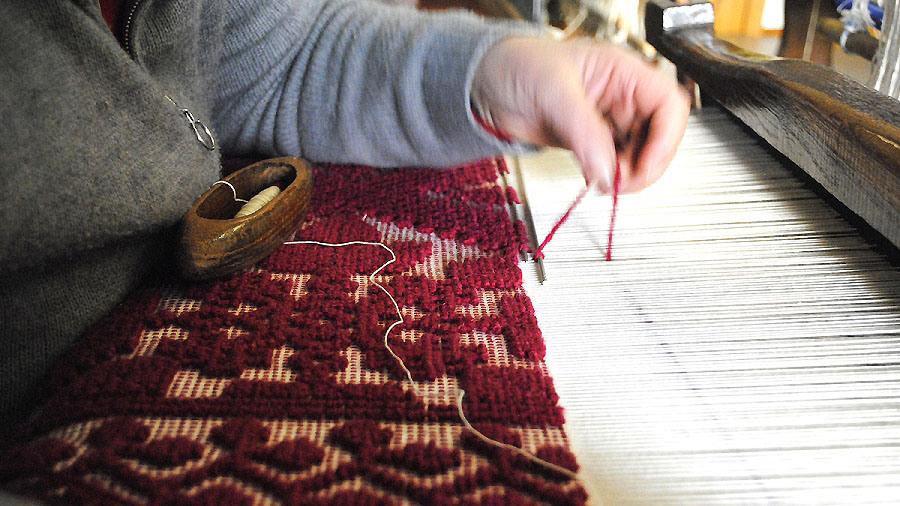Nule And The Sardinian Carpets 0 Comments

The Sardinian carpet is not only the floor rug: in Sardinia, it is woven and used also to cover the wooden chests. Its origins seem to be very far, starting with the mats that were already woven in the Neolithic. Then in the Roman and Byzantine era, we may already speak of proper rugs. Since weaving is one of the most widespread artisan activities throughout the island, it is mainly differentiated by decorations (in Sardinian, mostras), subdivided into geometric patterns, of plants, of the animal world, of heraldic symbols and mythological figures. For the weaving of tablecloths, curtains and linen cushions, they use a very laborious technique called a ranos (grain of wheat) or pibiones (grape berries) where a larger thread of extra weft is pulled out creating rings or picots in relief which will form the decorative motif.
Nule is famous for its traditional Sardinian wool carpets, a small town where the handmade weaving, performed in accordance with the ancient technique using a vertical loom, is art. They produce woollen carpets with a smooth weave, mainly with a dark background, or the typical “flame” carpet.
Visiting Nule was a remarkable trip. We went to see the work of a weaver who had been recommended to me by friends. 94 kilometres far from the Gabbiano Azzurro Hotel & Suites, it is just an hour and a half car ride. A long stretch of road without encountering a living soul, or signs of the inhabited area, only the rugged marvellous Sardinian nature. We stop to take a breath of the clean air smelling of soil, wind and plants’ resin and hearing the chiming of grazing flocks in the distance. On our arrival, with pleasant surprise, we realize that a celebration is in progress. In fact, we meet women who wear traditional clothes, long black skirts with colourful ruches, white shirts and black jackets. The head is covered with a black or embroidered white headscarves. Some men, also traditionally dressed, are on horseback, trotting along the narrow roads. The old ones dressed in black with the hat, sit on chairs in front of their doorstep, hands leaning on the stick, enjoying the villagers passing by. Behind the white lace curtains of the windows, a feminine hand slightly pushes the linen aside, for an outdoor glance. We feel to be projected into a timeless world, wonderfully alive and real. We find the laboratory we are looking for. She is a young girl, fascinated by her work, introducing us with great enthusiasm to the history of the Sardinian carpet.
Once it was customary for the family to prepare the trousseau for the bride-to-be daughter, and then put it in a chest especially manufactured and inlayed by the "maistru de linna", the master of wood. The chest was protected by the "copribanga" or "copericascia", the woollen cover-chest or cover-case. The same work will be employed for carpets, blankets, cushions, tapestries and curtains, making the furnishing of the future domus become precious.
After the shearing, the Sardinian sheep's wool is washed, sun-dried and carded to be worked with the loom. Then they proceed with the animal or vegetable origin colours dyeing. (Nowadays chemical colors are also employed being easily available). From the Corsican grass (su trubiscu) the black is obtained, from Pistacia lentiscus (su moddizzi) and from saffron (su zaffaranu - famous is the Saffron from San Gavino) the yellow, from madder plant (orixedda) the red, from the woad (guado) the indigo blue and finally from ash (ollastu de arriu) the brown. The loom tour guest is showing us is vertical and antique, made of oak, as used in the regions of Barbagia and Goceano (the region Nule belongs to). The carpet she is processing now is with flamed patterns where red, blue and green evoke exotic styles.
It is night already when we return home. In the car trunk we have a precious memory of the trip: a true, traditional, beautiful Sardinian carpet.
“Life is a tapestry we weave day by day with threads of different colours, some heavy and dark, others thin and bright, all the threads having their uses.” (Isabel Allende)
--
written by Daniela Toti
Teilen Sie uns Ihre Meinung mit!